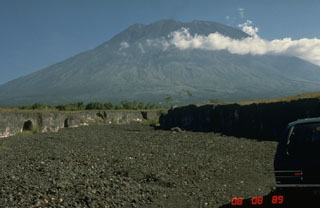Report on Agung (Indonesia) — November 1989
Scientific Event Alert Network Bulletin, vol. 14, no. 11 (November 1989)
Managing Editor: Lindsay McClelland.
Agung (Indonesia) Occasional seismicity but solfatara field quiet
Please cite this report as:
Global Volcanism Program, 1989. Report on Agung (Indonesia) (McClelland, L., ed.). Scientific Event Alert Network Bulletin, 14:11. Smithsonian Institution. https://doi.org/10.5479/si.GVP.SEAN198911-264020
Agung
Indonesia
8.343°S, 115.508°E; summit elev. 2997 m
All times are local (unless otherwise noted)
Observations from both Rendang (S) and Budakeling (N) Observatories revealed neither white plumes from the solfatara field nor collapses of loose material from the inner crater wall. No explosion sounds from the crater have been heard. An earthquake was felt (MM I) on 9 June; 59 tectonic and two volcanic shocks [were] recorded in November.
Geological Summary. Symmetrical Agung stratovolcano, Bali's highest and most sacred mountain, towers over the eastern end of the island. The volcano, whose name means "Paramount," rises above the SE rim of the Batur caldera, and the northern and southern flanks extend to the coast. The summit area extends 1.5 km E-W, with the high point on the W and a steep-walled 800-m-wide crater on the E. The Pawon cone is located low on the SE flank. Only a few eruptions dating back to the early 19th century have been recorded in historical time. The 1963-64 eruption, one of the largest in the 20th century, produced voluminous ashfall along with devastating pyroclastic flows and lahars that caused extensive damage and many fatalities.
Information Contacts: VSI.

